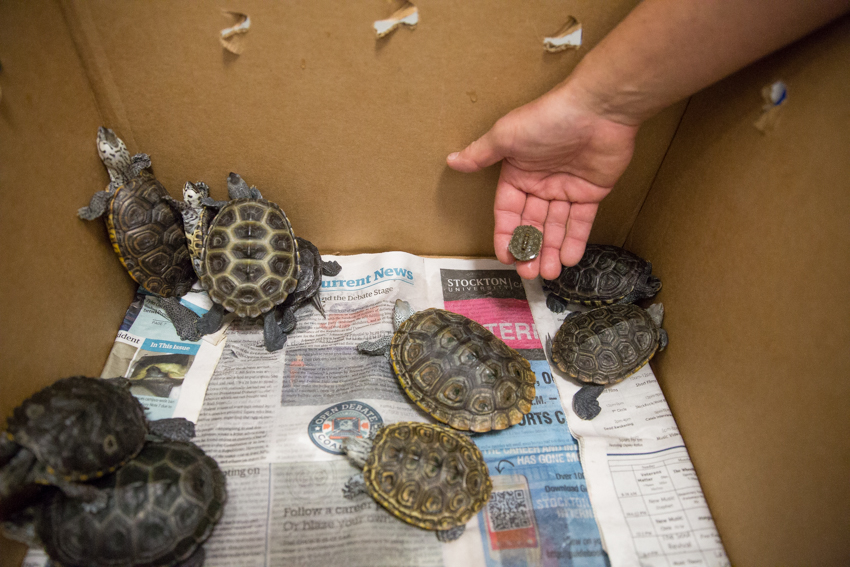Stockton Terrapin Conservation Reaches Next Generation
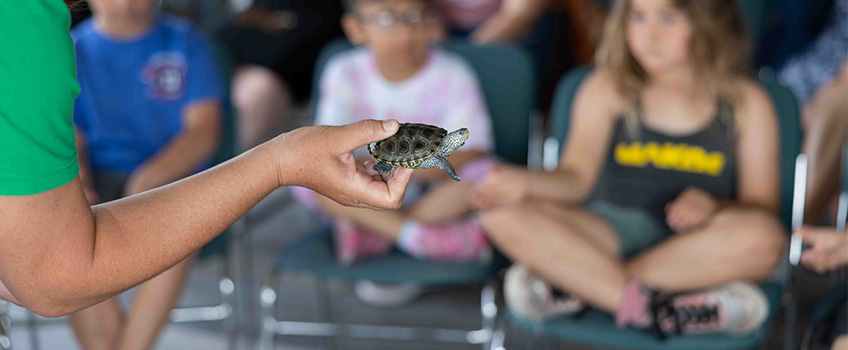
A rescued northern diamondback terrapin hatchling is about to return to the wild during a release at The Wetlands Institute with kindergartners from Stone Harbor School.
Galloway, N.J. — When John Rokita ‘78 got to his Stockton University office at 7 a.m., a voicemail from the Margate Terrapin Project greeted him. The group wanted to deliver two deceased northern diamondback terrapins carrying eggs.
A few hours later, a delivery arrived with 10 terrapin eggs nested in a box of sand along with a second container carrying a live adult terrapin with a badly cracked carapace (upper shell). The VanWingerden family rescued the eggs from a construction zone in Ocean City and found the injured female who was hit by a car on her way to or from nesting. She might be carrying eggs, too.
Rokita, assistant supervisor of the Vivarium and Collection Room Facilities, performs egg extractions on road-killed terrapins and incubates their eggs. For injured adults he uses epoxy to repair shell cracks.
“It’s like a triage system. You have to go with what you think needs your attention first and then you go from there. The phone is ringing off the hook usually from May until the end of August,” which is prime time for terrapin nesting, Rokita said.
Watch Baby Terrapins
Terrapin Enrollment is Rising
People in South Jersey know who to call for terrapin rescues. A viral handmade flyer recently posted on Facebook said, “Find a hurt turtle? Call John Rokita. Your help matters.”
Hundreds of terrapins ranging from the size of a quarter to full grown adults recovering from injuries live in Stockton University’s vivarium. The number of hatchlings reaches nearly 1,000 by the end of summer, but their stay is temporary.
Hatchlings bulk up over the winter in preparation for their return to the wild during releases in the spring, summer and fall.
“When we go to release them, they’re the size of a 3- to 4-year old terrapin that would occur naturally in the wild,” Rokita said.
They’re kept at 80 degrees and have the deluxe meal plan. They eat floating food sticks and fresh fish. Rokita and Melissa Laurino, an animal care specialist, provide 365 days of care with daily feedings and tank cleanings with the help of student workers.
If the Absecon Bay Sportsman Center bait and tackle shop is out of silversides fish, Rokita heads to the local ShopRite grocery stores.
“I clean out all their smelt. When I’m in line with 30, 40 or 50 bags of smelt, people next to me are asking for recipes, and I try to explain, it’s not for me,” he said.
Rescues enrolled in the head start program include hatchlings scooped out of storm drains, spring emergers or terrapins that hatch and spend the winter underground in the nest, dead females carrying eggs and injured females that get hit crossing the street to nest. Extracted eggs go into an incubator.
Storm drain rescues come in with infected eyes and skin from the oily and dirty water.
“They’re perfectly healthy when they fall in, but sometimes when they’re fished out, they do have problems. So, it really gives them a second chance because ultimately, they would die in the storm drain. There are probably so many more drains up and down the coast that never get looked at and unfortunately wind up as terrapin death traps,” Rokita said.
Young Rescuers Scoop Hatchlings
Rokita remembered receiving the first storm drain rescues from Evelyn (Ingargiola) Kidd ’11, a Political Science graduate who is now an occupational therapist.
Kidd, of Ventnor, credited her brother with showing her how to find and scoop terrapins from the drains. She hasn’t stopped.
With 30 years of experience, she’s been promoted to terrapin rescue supervisor of Jason “JJ”, 6, and Lily, 3, her two children.
After school one day, they headed straight to Ventnor’s Ski Beach with a long-handled net and bucket. They peered into the dark drains looking for movement in the water.
“There’s one,” JJ yelled.

Within seconds, he pulled the net through a thin slit in the drain with a terrapin no bigger than a quarter in the net.
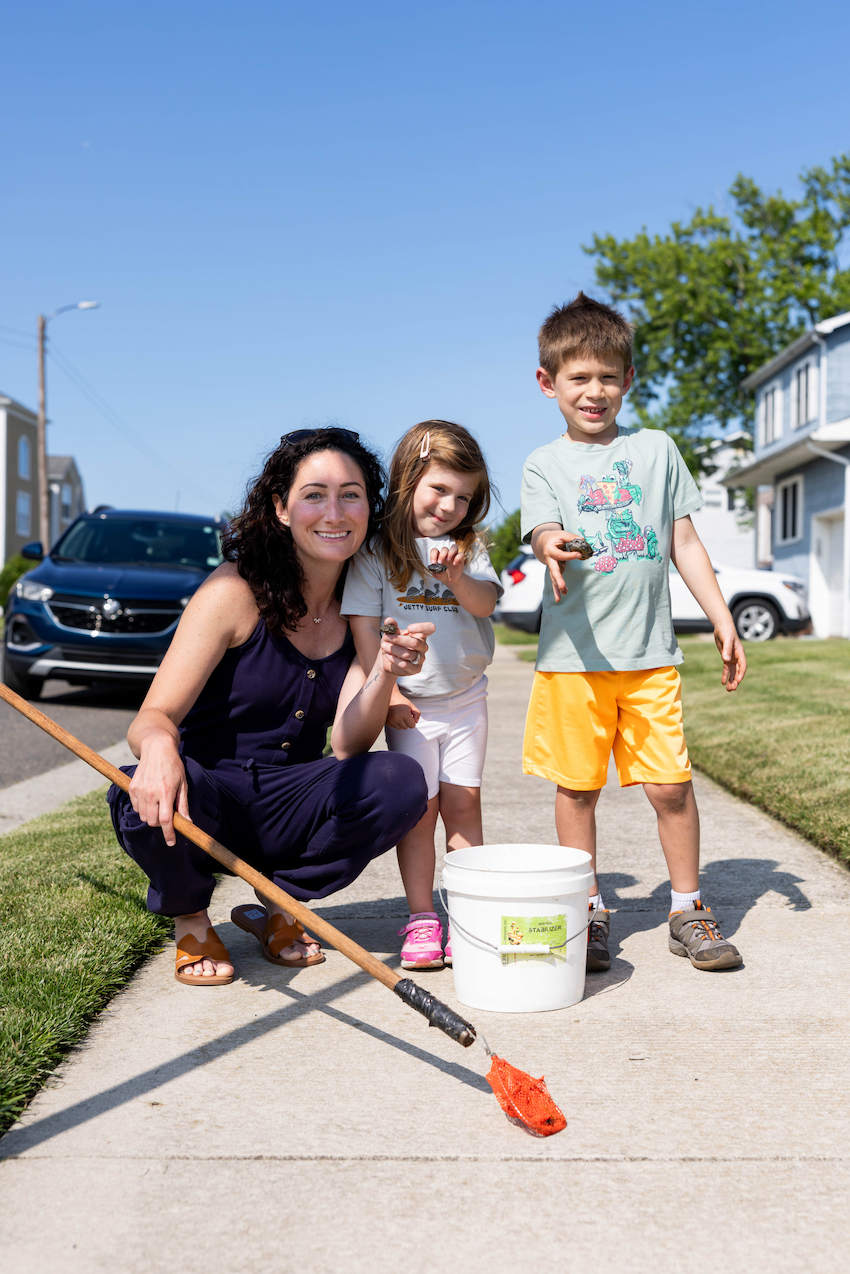
“You’re getting so good at this,” Kidd said.
Kidd remembered the days when terrapins crawled out of the bay and had options for nesting sites. Now that the waterfront is more developed and bulkheads have been installed, they only have one exit from the bay at the boat ramp and there are less places to nest.
“When I was little, I remember getting 15-30 a day and that was normal. Now, we get 10 a day in the height, and maybe 50 a season. I’ve seen the numbers go down, which has made me feel like I have to keep going. I’m tied to it,” she said.
JJ led the way to the next drain as Kidd followed giving Lily a piggy-back ride.
“JJ is the catcher and rescuer, and Lily is the caretaker. She holds them in her hands afterward and says, ‘Hey little guy, we’re going to rescue you,’” she said.
Stockton’s vivarium had reached capacity, so they delivered the hatchlings to Ray Scott’s Dock in Margate.
“My mommy did it, so I started to do it, and it’s getting really fun,” JJ said.
How It Began
Rokita, who has been working at Stockton since 1980, received the first hatchlings from Roger Wood, former Stockton professor and director of the Wetlands Institute.
Wood wanted to give road-killed terrapins a second chance by incubating any viable eggs that could be extracted and to give baby terrapins a head start.
Rokita kept the hatchlings in 10-gallon tanks in the animal lab, located in lower F wing at the time.
The 34-year partnership began.
Back to the Wild
On June 5, Rokita drove to the Wetlands Institute to meet with kindergarteners from Stone Harbor School for an annual release event. Twenty of the head starters were ready to graduate to the saltmarsh environment.
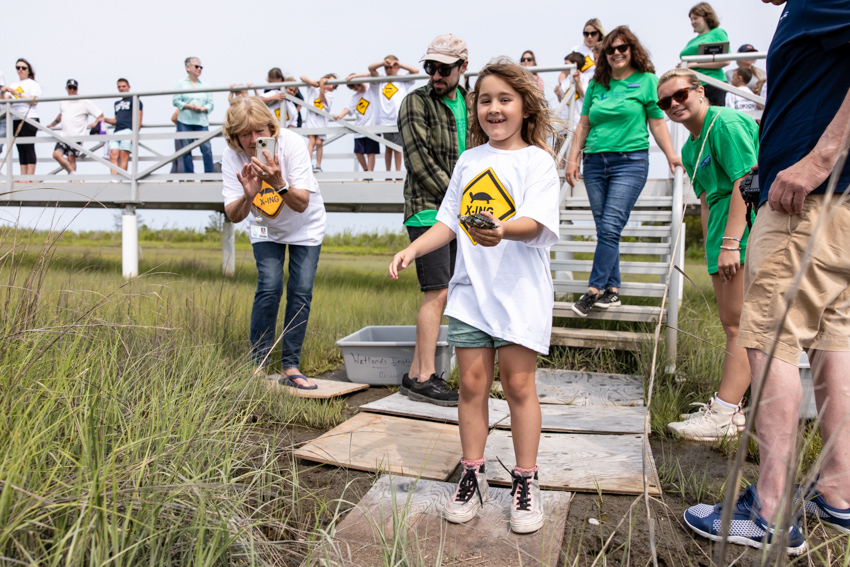
He was joined by Laurino, Lester Block and Tracy Nti Amankwah, of the School of Natural Sciences and Mathematics, and Hajar Faal, director of Academic Laboratories and Field Facilities.
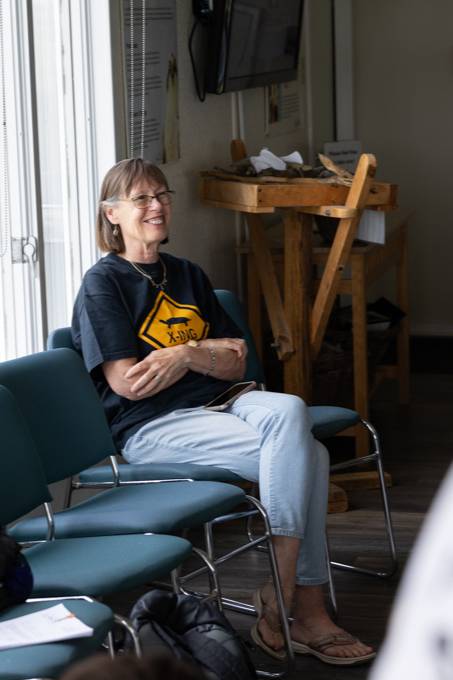
Roberta Dean, a retired kindergarten teacher who taught at Stone Harbor School for 28 years, was among the crowd. She was at the very first release in 1991.
“Dr. Roger Wood from Stockton was just starting to collect eggs from road-killed terrapins to incubate them, and I asked if the kindergarten class could help in some way,” she said.
She and the class decided to bake terrapin cookies to sell throughout the year to donate to the conservation effort, and Wood asked if the students could help him release the terrapins.
“As part of the curriculum, we were learning about money, so we were banking at Sturdy Savings across the street, and they said, we’ll match what you make, which was so thoughtful,” she said.
Lisa Ferguson, director of Research and Conservation at the Wetlands Institute, held up a terrapin to show this year’s kindergarten class.
This is a special terrapin because it went to school at Stockton, she explained.
Brian Williamson, a research scientist at the Wetlands Institute, brought out a scanner to show that the terrapin had been tagged with a microchip to help researchers track its growth and survival over the years.
“It’s always such a joy to see how excited the kids are, and it’s also so interesting that the parents learn a lot about the diamondback terrapins from the children. A lot of them come back to me and say, ‘I never knew anything about this.’ You’re not just teaching the child. The child is teaching the family,” Dean said.
And thanks to the microchips, she learns of resightings and is reminded that years of conservation work is making a difference.
Reporting and photos by Susan Allen
